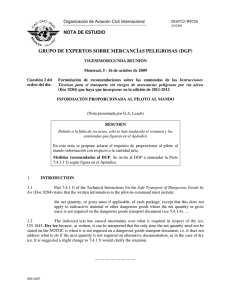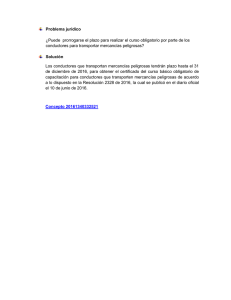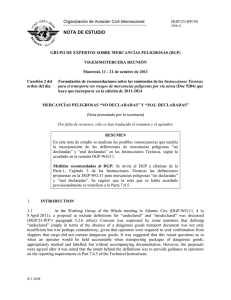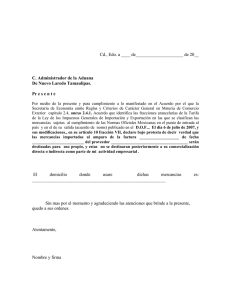grupo de expertos sobre mercancías peligrosas (dgp)
Anuncio
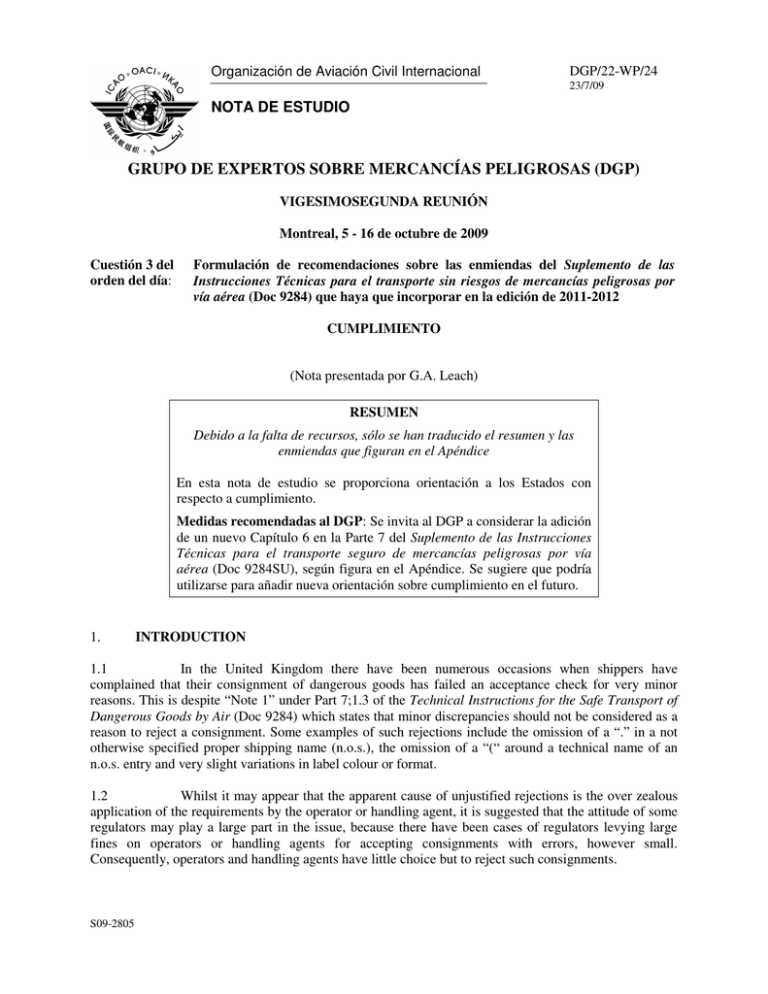
Organización de Aviación Civil Internacional DGP/22-WP/24 23/7/09 NOTA DE ESTUDIO GRUPO DE EXPERTOS SOBRE MERCANCÍAS PELIGROSAS (DGP) VIGESIMOSEGUNDA REUNIÓN Montreal, 5 - 16 de octubre de 2009 Cuestión 3 del orden del día: Formulación de recomendaciones sobre las enmiendas del Suplemento de las Instrucciones Técnicas para el transporte sin riesgos de mercancías peligrosas por vía aérea (Doc 9284) que haya que incorporar en la edición de 2011-2012 CUMPLIMIENTO (Nota presentada por G.A. Leach) RESUMEN Debido a la falta de recursos, sólo se han traducido el resumen y las enmiendas que figuran en el Apéndice En esta nota de estudio se proporciona orientación a los Estados con respecto a cumplimiento. Medidas recomendadas al DGP: Se invita al DGP a considerar la adición de un nuevo Capítulo 6 en la Parte 7 del Suplemento de las Instrucciones Técnicas para el transporte seguro de mercancías peligrosas por vía aérea (Doc 9284SU), según figura en el Apéndice. Se sugiere que podría utilizarse para añadir nueva orientación sobre cumplimiento en el futuro. 1. INTRODUCTION 1.1 In the United Kingdom there have been numerous occasions when shippers have complained that their consignment of dangerous goods has failed an acceptance check for very minor reasons. This is despite “Note 1” under Part 7;1.3 of the Technical Instructions for the Safe Transport of Dangerous Goods by Air (Doc 9284) which states that minor discrepancies should not be considered as a reason to reject a consignment. Some examples of such rejections include the omission of a “.” in a not otherwise specified proper shipping name (n.o.s.), the omission of a “(“ around a technical name of an n.o.s. entry and very slight variations in label colour or format. 1.2 Whilst it may appear that the apparent cause of unjustified rejections is the over zealous application of the requirements by the operator or handling agent, it is suggested that the attitude of some regulators may play a large part in the issue, because there have been cases of regulators levying large fines on operators or handling agents for accepting consignments with errors, however small. Consequently, operators and handling agents have little choice but to reject such consignments. S09-2805 DGP/22-WP/24 -2- 1.3 Whilst regulators may feel that by strictly applying the requirements they are improving safety, it is suggested the opposite may be true; if a shipper has gone to the trouble, effort and cost of correctly packaging, documenting, marking and labelling their consignment only to have it rejected, they may feel that it would be far easier not to declare the dangerous goods at all i.e. send the consignment as undeclared dangerous goods, which poses a far greater risk than the omission of a “.” or “(“. 1.4 A similar issue arises with the reporting of incidents. Part 7;4.4 and 4.5 of the Technical Instructions and Part S-5;4.5 of the Supplement refer to the reporting of dangerous goods accidents and incidents and instances of undeclared or misdeclared dangerous goods found in cargo or baggage. It is suggested the main aim of requiring the reporting of dangerous goods incidents and accidents is to enable people to learn from such incidents so as to prevent recurrences. It can also identify deficiencies in the Technical Instructions. However, for such a scheme to work, it is important that reporters are able to report without fear of retribution due to mistakes they or their company may have made. For example, if dangerous goods which did not comply with the Technical Instructions were found after they had been carried by air, it would be desirable for this to be reported. However, the discoverer may feel inhibited about making a report because of the possible consequences for his colleagues or employer in having accepted them for carriage. 1.5 It is suggested that it would be appropriate to offer guidance to States in the Supplement on the subject of enforcement. ———————— DGP/22-WP/24 Apéndice APÉNDICE PROPUESTA DE ENMIENDA DEL SUPLEMENTO DE LAS INSTRUCCIONES TÉCNICAS Parte S-7 OBLIGACIONES DEL EXPLOTADOR ... Capítulo 6 CUMPLIMIENTO 6.1 En la Parte 7;1 de las Instrucciones Técnicas se requiere que el explotador lleve a cabo una verificación para la aceptación de los bultos que contienen mercancías peligrosas y la documentación conexa para asegurar, en la medida de lo posible, que se hayan cumplido los requisitos de las Instrucciones Técnicas. En general, los explotadores no deben aceptar mercancías peligrosas para el transporte por vía aérea si la verificación para la aceptación demuestra que hay errores en el envío. Sin embargo, en la Nota 1 de 7;1 se indica que las discrepancias menores en la documentación, las marcas o las etiquetas no deberían considerarse como motivo para rechazar un envío. La experiencia ha demostrado que el rechazo de mercancías peligrosas por razones menores aumenta la probabilidad de que las mercancías vuelvan a presentarse para el transporte sin declararlas. En consecuencia, los Estados no deberían penalizar a los explotadores y agentes de servicios de escala que aceptan mercancías peligrosas a pesar de haber observado discrepancias menores. 6.2 La Parte 7;4.4 y 4.5 de las Instrucciones Técnicas y la Parte S-7;4 se refieren a la notificación por el explotador de los accidentes e incidentes relacionados con mercancías peligrosas, los casos de mercancías peligrosas no declaradas o mal declaradas que se encuentran en la carga y las mercancías peligrosas prohibidas que se encuentran en el equipaje. El principal objetivo de todo sistema de notificación de incidentes debería ser fomentar la seguridad de vuelo y no castigar. Por consiguiente, los Estados deberían asegurar la notificación libre y sin restricciones de lo siguiente: a) accidentes e incidentes relacionados con mercancías peligrosas; b) casos en que se descubren mercancías peligrosas no declaradas o mal declaradas en la carga; y c) casos en que se descubren mercancías peligrosas no permitidas de conformidad con 8; 1.1.2 de las Instrucciones Técnicas, en el equipaje de los pasajeros. Cuando el explotador notifica un incidente debido a incumplimiento no premeditado o involuntario de los requisitos de las Instrucciones Técnicas, los Estados no deberían iniciar procesos contra él, salvo en casos de negligencia o imprudencia grave o de que ya se haya recibido un informe de otra fuente. — FIN —
